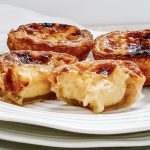
Pastéis de Nata - Portuguese Custard Tarts
Glorious, silky smooth, cinnamon and lemon scented custard in a light and crispy, buttery puff pastry. My idea of absolute heaven.
Ingredients
Puff pastry:
- 285g – 300g puff pastry either homemade (see here) or shop bought
For the custard:
- 200g caster sugar
- 125g water
- 6g lemon peel
- ½ cinnamon stick
- 250ml full fat milk
- 38g plain/all-purpose flour
- 3 eggs yolks
- ½ large egg (beat the egg, weigh and remove half)
- 20g unsalted butter
- pinch of fine salt
Instructions
-
Collect together your equipment (see Recipe Notes below) and ingredients.
-
First make the puff pastry – if you are making your own pastry, you need to make this first. You should start making it 5 – 5½ hours before you want to make the tarts.
-
Preheat oven to Fan Oven 290°C /310°C/550°F/Gas 10 or as hot as your oven will heat.
-
Secondly, make the custard, starting time time for it to cool down – heat the sugar, water, lemon peel and cinnamon over a moderate heat until the sugar has dissolved, and it reaches 106°C/223°F. It will turn into a thick syrup.
-
Strain the syrup.
-
Meanwhile, in a heatproof jug, mix the flour with 95ml milk to make a paste.
-
Bring the remaining milk to a simmer and, when steaming, pour over the milk and flour paste and mix thoroughly with a balloon whisk.
-
Wash the saucepan thoroughly – this is an important step. If you do not do this, your custard may stick to the base of the pan and burn.
-
Pour the milk and flour back into the clean saucepan. Heat over a moderate temperature and cook, stirring for 3 minutes, until thickened.
-
Slowly add the syrup to the flour and milk, whisking all the time.
-
In a large bowl, beat the eggs – slowly add the custard, beating as you pour it in with a balloon whisk.
-
As soon as it is all incorporated, add the butter and beat until it is incorporated.
-
Strain the custard into a jug or bowl.
-
Cover with cling film and set on one side.
-
Line the Pastéis de Nata or muffin tins with pastry: on a lightly floured work surface and with the short side of the pastry in front of you, roll out the pastry roughly 35cm/14in – 40cms/16in long and 10cms/4in wide.
-
Brush off excess flour.
-
Start rolling the long side of the pastry, brushing off extra flour, with each small roll, until it is completely rolled.
-
Trim the ends from each end of the pastry.
-
Slice the pastry into rounds. If you are using Pastéis de Nata tins (as shown) each round of pastry should weigh 20g. If using a muffin tin, you will need 28g of pastry per muffin size tart. You will make between 10 – 15 tarts depending on the tin size. Place a pastry round into a greased tin.
-
Use your thumb and press the centre of the pastry. Continue pressing the pastry encouraging it to come up the sides of the tin. It needs to extend a little higher than the tin.
-
Now use your thumb to press down on top of the pastry so it comes to the same level as the tin and create a slightly thicker pastry crust at the top, around the edge.
-
Place the tins on a baking tray.
-
Fill the tins and bake the tarts: pour custard into the pasty cases, to just below the thickened area of pastry. They should be around four fifths full.
-
Bake at the top of a pre-heated very hot oven for 8 – 9 minutes until the custard has risen and is in a dome shape. The custard should be set but still be wobbly – it will continue to cook when you take it out of the oven – and the top of the tarts should be dark and caramelised. As the custards cool, the dome shape will settle and flatten.
Recipe Notes
Equipment:
- kitchen scales and measuring spoons
- Saucepan
- jug
- sieve
- mixing bowl
- Pastéis de Nata or muffin tins, well greased